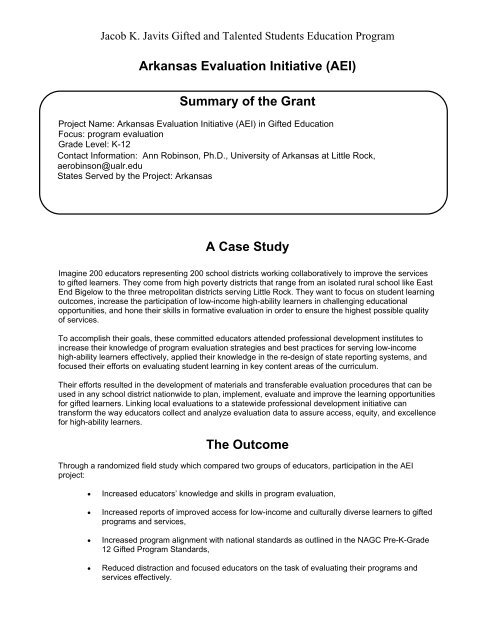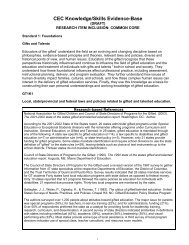Advanced Readers At Risk: Rescuing an Underserved ... - NAGC
Advanced Readers At Risk: Rescuing an Underserved ... - NAGC
Advanced Readers At Risk: Rescuing an Underserved ... - NAGC
Create successful ePaper yourself
Turn your PDF publications into a flip-book with our unique Google optimized e-Paper software.
Jacob K. Javits Gifted <strong>an</strong>d Talented Students Education Program<br />
Ark<strong>an</strong>sas Evaluation Initiative (AEI)<br />
Summary of the Gr<strong>an</strong>t<br />
Project Name: Ark<strong>an</strong>sas Evaluation Initiative (AEI) in Gifted Education<br />
Focus: program evaluation<br />
Grade Level: K-12<br />
Contact Information: Ann Robinson, Ph.D., University of Ark<strong>an</strong>sas at Little Rock,<br />
aerobinson@ualr.edu<br />
States Served by the Project: Ark<strong>an</strong>sas<br />
A Case Study<br />
Imagine 200 educators representing 200 school districts working collaboratively to improve the services<br />
to gifted learners. They come from high poverty districts that r<strong>an</strong>ge from <strong>an</strong> isolated rural school like East<br />
End Bigelow to the three metropolit<strong>an</strong> districts serving Little Rock. They w<strong>an</strong>t to focus on student learning<br />
outcomes, increase the participation of low-income high-ability learners in challenging educational<br />
opportunities, <strong>an</strong>d hone their skills in formative evaluation in order to ensure the highest possible quality<br />
of services.<br />
To accomplish their goals, these committed educators attended professional development institutes to<br />
increase their knowledge of program evaluation strategies <strong>an</strong>d best practices for serving low-income<br />
high-ability learners effectively, applied their knowledge in the re-design of state reporting systems, <strong>an</strong>d<br />
focused their efforts on evaluating student learning in key content areas of the curriculum.<br />
Their efforts resulted in the development of materials <strong>an</strong>d tr<strong>an</strong>sferable evaluation procedures that c<strong>an</strong> be<br />
used in <strong>an</strong>y school district nationwide to pl<strong>an</strong>, implement, evaluate <strong>an</strong>d improve the learning opportunities<br />
for gifted learners. Linking local evaluations to a statewide professional development initiative c<strong>an</strong><br />
tr<strong>an</strong>sform the way educators collect <strong>an</strong>d <strong>an</strong>alyze evaluation data to assure access, equity, <strong>an</strong>d excellence<br />
for high-ability learners.<br />
The Outcome<br />
Through a r<strong>an</strong>domized field study which compared two groups of educators, participation in the AEI<br />
project:<br />
• Increased educators’ knowledge <strong>an</strong>d skills in program evaluation,<br />
• Increased reports of improved access for low-income <strong>an</strong>d culturally diverse learners to gifted<br />
programs <strong>an</strong>d services,<br />
• Increased program alignment with national st<strong>an</strong>dards as outlined in the <strong>NAGC</strong> Pre-K-Grade<br />
12 Gifted Program St<strong>an</strong>dards,<br />
• Reduced distraction <strong>an</strong>d focused educators on the task of evaluating their programs <strong>an</strong>d<br />
services effectively.

















